Globally, more than 1 billion fans support tennis. Because of this, and the fact that it sees its player base growing exponentially in recent times, tennis is now the world’s fourth most popular sports. Furthermore, the list of the world’s top 10 best-paid athletes has a tennis player – Roger Federer – in it. Consequently, it’s a little wonder to see more players opting to start playing tennis as beginners. This group features players who don’t know much about tennis but are willing to learn and always seek opportunities to add to their knowledge base. It’s for this group that we write this review. Through it, you can learn everything you wish to know about the best tennis rackets for beginners. Enjoy!
Table of Contents
1) Babolat Pure Drive
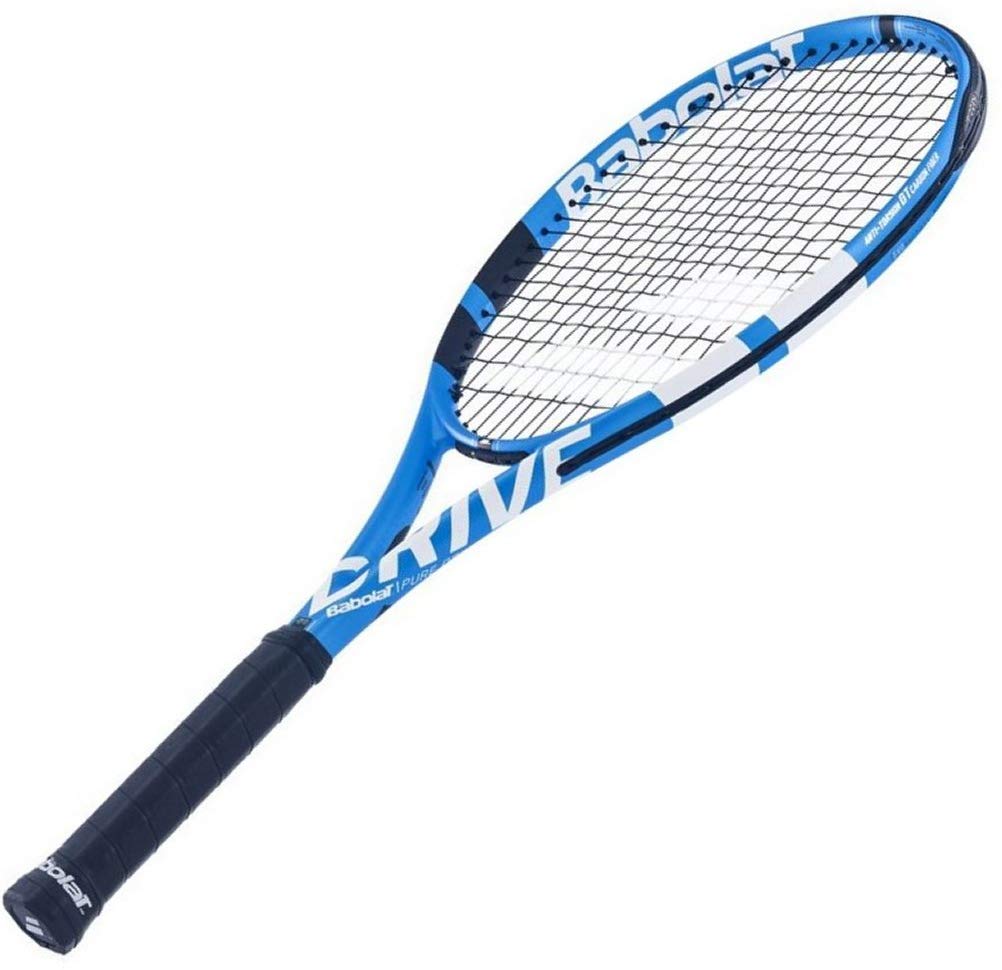
One of the first attractions you will notice about Babolat Pure Drive is the fact that it guarantees you the much-needed stability and control. Moreover, it also performs admirably in terms of providing the comfort that beginners need when handling a racket. As if that’s not enough, you will enjoy the SMAC technology that the racquet features. Through this technology, the racket can absorb all the shock experienced when hitting the ball. Consequently, you will enjoy striking the ball despite your lack of experience.
What is more, the spring spacing on the racket is quite wonderful too. Courtesy of the spacing, which is only possible because of the FSI technology, the beginner has a racket that delivers not only extra spin but also more power.
Pros
- Adds more power to each shot
- Extremely lightweight thus providing the oomph for faster swing speeds
- Comes with an adjusted sweet spot at off-center
- Easy to use for beginners who lack any tennis experience
- It is available in multiple grip sizes
Cons
- The stringing has a different feel, which many beginners don’t appreciate
- Many players consider the off-center sweet spot a bit of a turnoff
2) Head Liquidmetal 8
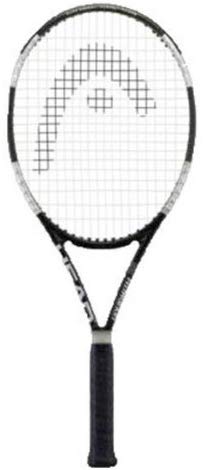
This oversized racket is one of the best for beginners. For starters, its sweet spot is huge enough to help you strike the ball nicely. Furthermore, its construction makes the racket light and well-balanced thus not leaving you tired during the game. Beginners need to be as comfortable as possible to keep the passion burning. Fortunately, this racket goes a long way into making them play comfortably.
What is more, beginners are likely to find its large surface and superb power quite attractive too. If that’s not enough to persuade you, then it would please you to note that the racket delivers solid shots. You can also rely on it to provide exceptional control and unmatched stability for a beginner.
Pros
- Lightweight enough not to interfere with a beginner’s maneuverability
- The best option for a beginner as it’s easy on the arms, wrists, and shoulders
- Pre-strung thus allowing beginners to start playing immediately
- Recommended for beginners
- Perfect racket for maximizing energy and power output courtesy of its liquid metal technology
- Extended sweet spot area
Cons
- Can be distracting to advanced players who may grow over-dependent on it
- Limited in terms of color
3) Head Ti.S6
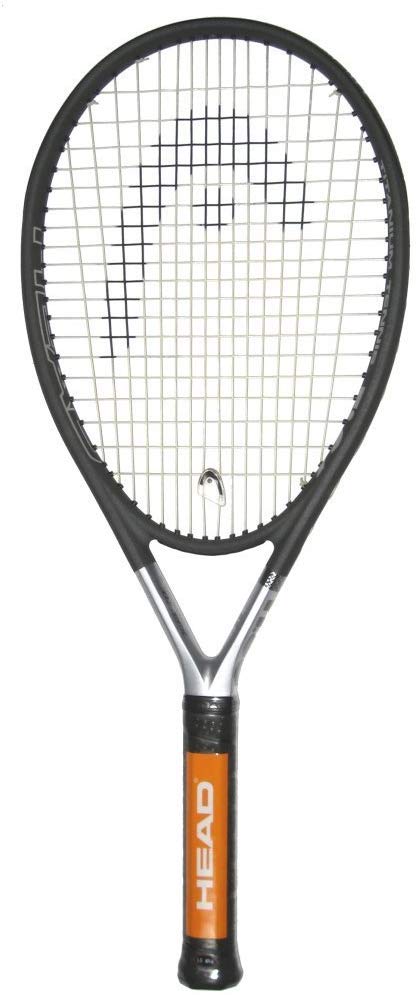
Beginners may not be aware of what makes Head’s rackets some of the best in the world in different categories. Whether one is a veteran or novice tennis player, Head has some of the most outstanding and high performing rackets in the market. In this regard, Head Ti.S6 will not disappoint you. Instead, it will leave you feeling excited about playing tennis for the first time. Some of its most amazing features include the oversize head, comfortable SofTac Grip, and ShockStop system. The fact that the racket is pre-strung is also fantastic news to players who have no idea how to prepare such a tool. Furthermore, it’s made of graphite and titanium construction that make it strong yet light!
Pros
- Light and agile
- Durable thus saving beginners from returning to the store to buy new ones
- Its construction gives it superb strength without making it unnecessarily heavy
- Perfect racquet for beginners as well as casual and recreational players
- Guarantees maximum power courtesy of its oversize head
- Sturdy and comfortable grip because of SofTac technology
- Reduced vibration due to ShockStop
- Ultra-lightweight thus not likely to cause tiredness on beginners’ hands and shoulders
Cons
- The racket does most of the work for players hence making it a poor choice for highly experienced players
- The racket’s design places more emphasis on power thus likely to cause tons of vibration on shoulders, hands, and elbows
4) Babolat Boost Drive
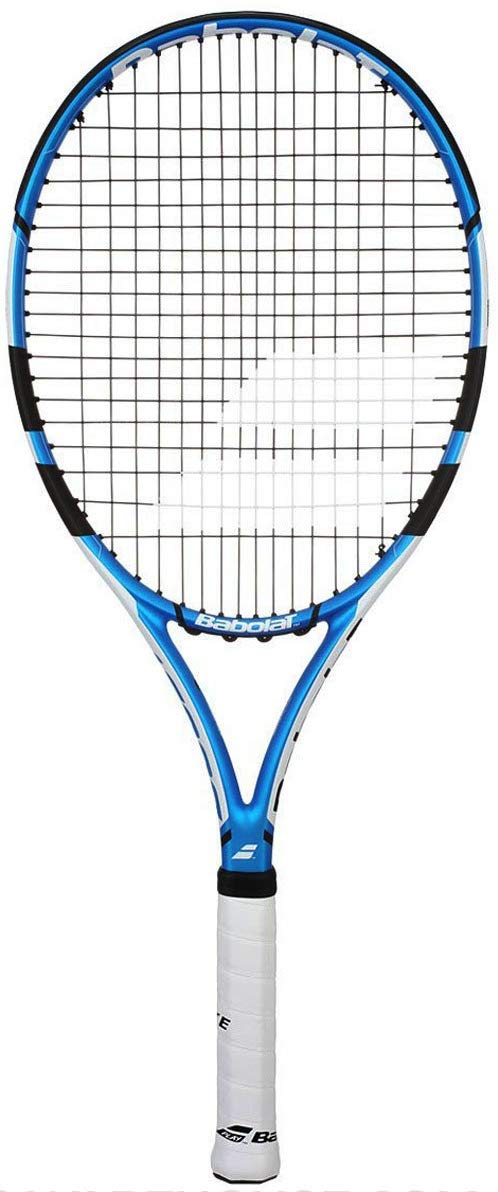
Are you a recreational tennis player? Do you consider yourself a beginner or casual player? If your answer to any of these questions is yes, then the Babolat Boost Drive would be your best racket. It’s perfect for anyone interested in a racket that performs solidly. The racket’s ultra-maneuverable weight remains one of its most impressive attractions. Through its weight, beginners have access to a racket that delivers exemplary pace and spin.
What is more, it’s understandable that beginners would often make less-than-perfect shots. Fortunately, the racket’s 105-inch head size provides ample room to take care of the imperfect strikes. Its grommet system makes the racket more comfortable and powerful too!
Pros
- Adds more power to each shot
- Ultra-lightweight thus guaranteeing the fast swing speeds that beginners need
- It has a highly adjustable sweet spot
- Classic and elegant construction and feel
- Delivers smooth control to all beginners
- Fairly reasonably priced
- One of the best pre-strung rackets for beginners
Cons
- The stringing has a new feel that most beginners struggle with
- Not all players enjoy the racket’s off-center sweet spot
5) Wilson Clash 100

Wilson Clash 100 is not just one of the world’s best tennis rackets for beginners. More than that, it also acts as one of the most highly recommended tennis rackets. The soft racket provides more flexibility that beginners need while training or taking part in a serious tennis match. Many times, the rackets that beginners use leave them with shock waves running up the arms upon hitting a ball. With this racket, such problems are non-existent! For this reason, you would not feel like you’re hitting the tennis ball with a piece of dry, flat wood. The racket comes with plenty of innovative technology. More impressively, its frame is neither heavy nor stiff! Additionally, the racket is stable, thus providing the needed control, spin, and power!
Pros
- Flexible feel
- Packs awesome power
- Delivers stunning spin
- The racket is highly swift thus giving beginners an advantage over their opponents
- Its stable smart and FreeFlex technologies deliver faster mechanics
- Eased acceleration pace is great at providing additional spin and pace
- Delivers stunning results in terms of power and speed
- Comfortable maneuverability when striking the ball either backhand or forehand
Cons
- Not easily affordable
The launch angle could be a bit problematic to beginners
6) Head Graphene Extreme MP
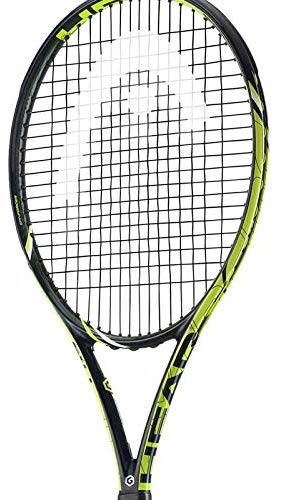
Any beginner interested in improving groundstrokes, volleys, and serves should get one of the best tennis rackets in the world; that is, Head Graphene Extreme MP. With this racket in your hands, you can expect to see a huge improvement in your execution on the tennis court. In addition to that, much of its weight is no longer on the racket’s throat. Instead, it’s on the tips of its frame. For this reason, the racket is now one of the most maneuverable. More importantly, it’s also a highly powerful racket in the hands of a beginner too. Furthermore, a beginner who appreciates the importance of an excellent spin would dash for this racket too. Start using it to improve your volleys and serves today to move up the ladder!
Pros
- Excellent power
- Wonderful spin
- Perfect for beginners who wish to get better at tournament matches
- Ideal construction for maximum playability and stability
- Comes with a special grommet that increases string movement
- Any impact with the ball creates a stunning trampoline effect
Cons
- Not easy to control
- May feel a bit stiff
A Beginner’s Guide To Selecting A Tennis Racket
The process of purchasing a new racket, or really any type of tennis gear, particularly when you are a newcomer to the game, can be a true challenge. Few people are interested in paying a great deal of money for a highly personal piece of sporting equipment unless it is clear that they are making the right choice. Having a tennis racket that is perfectly suited to your body mechanics, style of play and other important factors can make a massive difference in a player’s performance.
However, it is not always easy to know where to go for good advice on picking a tennis racket. We at Racquet Research are committed to helping you get precisely what you need when it comes to tennis equipment, and we have put together a comprehensive guide that details everything you ought to understand before buying your racket. By heeding the tips outlined in the paragraphs that follow, you will be uniquely equipped to make a sound decision that can make the game far more enjoyable than you ever imagined.
Here we go!
Your Personalized Racket Needs
You might think it odd to ask yourself what it is you truly need out of a racket. However, it really is a critical question for anyone preparing to make this kind of purchase. Money wasted on an unsuitable racket can not only be an unnecessary financial hit, it can also diminish your enjoyment of the game and prevent you from developing your skills as much as possible.
Humans routinely select things that may not be optimal for their needs, and they tend to do so for a whole host of reasons. As an example, a racket that is vividly colored or just simply looks good may be an easy sell, despite any other attributes that are less-than-ideal for an individual player. It is all too easy to be overcome by beauty to the detriment of function.
As such, we have compiled a list of key questions to explore prior to shopping for a racket. It is best to avoid shopping altogether until these issues have been addressed.
Physical Size And Bodily Strength
There are some rackets that are designed to suit players of different physical sizes and strength levels. If you are gifted with great strenght, you will probably want a racket that offers a higher level of control and does not provide a power boost. Weaker individuals may opt for the opposite and seek a racket that does generate additional power.
Broadly speaking, rackets with wider frames produce a greater degree of power. When you watch the professionals play, you will probably see that their rackets generally do not have wide frames. The reason is that these players already possess significant power and do not need the racket to generate it for them.
As we discuss frame width, we are really speaking about the section of the racket that is shown in this picture. This area of the racket is known as the “throat,” and it is where the greatest impact on the ball originates. Therefore, a frame that is wide at the throat will tend to provide greater power than one that has a narrower throat portion.
In addition to physical strength, it is necessary to consider your stature when selecting a racket. Taller players typically have long arms, and as such, their swing wil also be longer. This, in turn, produces more power and greater speed. Shorter players have short swings, and can thus generate less power. This is not universally true, however, and some short players are powerful hitters. These are just broad observations that can help guide your decision-making process.
Assessing Your Own Swing
Players will have either an average, fast or slow swing. A reputable coach or even an experienced player will have no problem watching your swing and letting you know which of these you have. Fast swings tend to produce greater power than slower ones, and as such, a less powerful racket makes sense for fast swingers. Control is key for such individuals, so narrow frames are ideal.
Learning The Style Of Play You Favor
Do you tend toward aggressive play on the court or are you more of a defense-oriented player? The majority of players will be one or the other or these, and these tendencies really do influence the sort of racket that makes the most sense to buy. Aggressive players usually try to hit the ball harder, and that means that a powerful racket may work best. Defensive players often try to respond mainly to the speed of the ball that is hit to them by an opponent, a fact which may make a narrow-framed option the better choice. Your swing speed and physical stature should also be factored into your thinking on this.
Considering A Racket’s Technical Specifications
Tennis rackets may seem fairly simple on first glance, but this certainly isn’t the case. The various technical elements of a racket have the ability to make a massive difference in how you play the game. The key is to become familiar with these factors prior to selecting the racket you will buy. Below, we outline the critical distinctions among rackets and some insights on how they can alter your play and overall performance on the court.
Size Of Racket Head
Generally, this is anywhere between 95 and 100 inches. A larger head will produce greater power and offer a bigger sweet spot, which faciliates good shots. A smaller head brings greater control, so if you are capable of hitting well and already have lots of power, this may be the way to go. Many will remember when tennis legend Roger Federer switched from a smaller to a larger head toward the later stages of his career in order to gain a more powerful backhand.
Racket Length
An adult racket tends to be anywhere from 27 to 29 inches in length, but most are closer to 27. A longer racket will usually weigh less than a standard one and will provide greater reach and additional serve power, given the steeper downward angle that is achievable. However, it should be noted that longer rackets are more difficult to control, so it is necessary to be certain it works for you before you buy a longer-framed option.
Racket Weight
A racket’s weight is significant in terms of a player’s swing, and it should thus be considered carefully before any purchase. The majority of racket makers offer the same racket in a number of different weights, so there is nothing wrong with asking or searching for the one you like at the appropriate weight. A heavier tennis racket (one that weighs at or above 320 g) will offer more power than a lighter one (weighing 310 g or under). However, such a racket is more difficult to wield and can be tiring for a player. Keep in mind that a racket’s string tends to add roughly 30g to the total weight.
Racket Balance
This represents a difficult topic, because it is a personal preference. As such, it is wise to try a number of different rackets to determine if you like weight to be distributed more toward the racket’s head (where the strings are) or toward the body of the racket near the throat and handle. Rackets that are heavier in the head tend to be lighter, bring greater power to the groundstroke, whereas rackets that are light in the head tend to weigh more, but are easier to wield.
Racket Stiffness
The degree to which a racket flexes at the point of impact will have great bearing on the comfort and power it provides. A frame that is stiff will result in less energy loss when the ball is hit, though a greater shock will be feld in the arm and hand.
Other Key Factors To Consider
Size Of Grip
All players have different hand sizes, and it is therefore necessary to take note of this factor when choosing a racket. Tennis rackets can be found in an impressive array of grip dimensions, and the best way to determine what is best for you is to actually hold a broad selection in your own hands and even play with several as well.
A smart way to figure out a racket’s grip size is to measure the distance between the ring finger’s tip (on the hitting hand) and the palm’s second line. Refer to the picture for the proper technique. The length (in millimeters) is made to correspond with the racket handle’s perimeter. On the perimeter, the perfect grip size is determined. See the table to learn more.
If uncertainty persists, it is suggested that you purchase a racket that has a slightly smaller size grip than you truly need, and then you can purchase an overgrip to place on top of the racket’s own grip. These are inexpensive and are easily replaceable as they show signs of wear and tear. Therfore, you will always be able to have a new grip for very little money, and your ability to hold the racket will be all the better for it.
Wrapping an overgrip can be tough for beginners, so consider asking a professional for help. With practice, it will become much easier to do. Swapping out your grip every 10-20 tennis games is a solid recommendation, but this will depend on how much your hand sweats during a typical match.
Purchasing Just The Frame With No Strings
Newcomers to tennis should pay serious attention to the following advice. Great care should be taken when purchasing a racket that is pre-strung. The strings used on such rackets tend to be of poor quality, and the stringing process occurs in a factory where sufficient attention is unlikely to be used. Therefore, consider buying a racket that does not have strings (or a “frame-only” option). Then, you can enlist the help of a professional racket stringer who can complete the process for you. While this will be a bit more expensive, the difference is tremendous, and your game will improve as a result. Few things are more frustrating for tennis aficionados than watching someone play with a high-end racket that has poor quality strings.
When you give this a little more thought, it really does make sense. Strings serve as the surface that makes contact with the ball, so not taking the time or going to the expense of making sure they are the best they can be is serious error. Stop and think why tour professionals tend to switch rackets so frequently during any given match. The reason is that they know that strings can undergo significant changes over the course of a single match, and they need consistency for the entire event.
Purchasing Multiple Rackets At Once
Picture yourself participating in a critical match, and at a key point in time, your racket strings breack (something that is inevitable). What is your solution? Will you attempt to borrow a friend’s racket, even though their set-up will be customized for them and totally different from what you need. Alternatively, you can call a halt to the match and forfeit, which would be truly disappointing for all involved. We recommend that you never set foot on a court unless you have no fewer than two rackets of the same make and which bear the same strings at identical tension levels. That way, should you suffer a mid-match string break, you will be able to swap rackets and continue on as if nothing happened.
Conclusion
As seen from the review above of the best tennis racquets for beginners, there’s plenty to choose from. Remember, a racket is capable of affecting your play. More crucially, it’s also important in influencing your passion towards the game positively. For this reason, you need as much information as possible to help you choose the best racket. We provide all that information above in the review. The hope is that you will now have a much easier time separating the best from the rest. Consequently, you will have a racket that offers plenty of control and is full of power, spin, and pace. Therefore, place your order for the most suitable racket for a tennis beginner and start enjoying playing the beautiful game of tennis!


Leave a Reply
Want to join the discussion?Feel free to contribute!